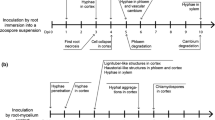Abstract
Fusarium wilt-resistant ‘Novada’ and wilt-susceptible ‘Early Sam’ carnations were planted in soil infested withFusarium oxysporum f.sp.dianthi, and their roots studied after five and ten weeks. Both in ‘Novada’ and ‘Early Sam’, the extravascular tissue of undamaged young root parts were scarsely colonized. In roots of ‘Novada’, infected xylem vessels were usually occluded with gums and surrounded by phellem tissue. In mature parts of roots, the phellem surrounding occluded vessels often merged with the external phellem surrounding the vascular cylinder, after which the occluded vessels were shed from the roots. The phellem at the root surface appeared to be a strong barrier to fungal invasion. In roots of ‘Early Sam’ carnations, as well as in a few roots of ‘Novada’ carnations, the defence responses did not result in compartmentation of the fungus, and colonization and degradation of the vascular tissues followed. Diseased roots finally healthy. Shoots of ‘Early Sam’ carnations, and eventually a few shoots of ‘Novada’ carnations, were colonized and developed wilt symptoms.
Samenvatting
Resistente ‘Novada’ en vatbare ‘Early Sam’ anjers werden geplant in grond besmet metFusarium oxysporum f.sp.dianthi. Na vijf en tien weken werden de wortels van de planten bestudeerd. De extravasculaire delen van onbeschadigde jonge wortelgedeelten waren in beide cultivars nauwelijks gekoloniseerd. In de wortels van ‘Novada’ waren geïnfecteerde houtvaten meestal verstopt door gommen en omgeven door kurkweefsel. In oudere wortelgedeelten sloot het kurkweefsel rond verstopte vaten vaak aan op het kurkweefsel aan de buitenkant van het vaatweefsel, waarna de aangetaste vaten werden uitgestoten uit de wortel. Het kurkweefsel aan het worteloppervlak leek een belangrijke barrière te vormen tegen het binnendringen van de schimmel. In de wortels van ‘Early Sam’ en in enkele wortels van ‘Novada’ mislukte het afweerproces, en werd het vaatweefsel door de schimmel gekoloniseerd en vervolgens afgebroken. Aangetaste wortels werden na afloop van tijd hol. De bovengrondse delen van de meeste ‘Novada’ anjers werden niet gekoloniseerd en bleven gezond. De bovengrondse delen van de ‘Early Sam’ anjers, en op den duur die van enkele ‘Novada’ anjers, werden gekoloniseerd en verwelkten.
Similar content being viewed by others
References
Baayen, R.P., 1986. Regeneration of vascular tissues in relation to Fusarium wilt resistance of carnation. Netherlands Journal of Plant Pathology 92: 273–285.
Baayen, R.P., 1988. Responses related to lignification and intravascular periderm formation in carnations resistant to Fusarium wilt. Canadian Journal of Botany, in press.
Baayen, R.P. & Elgersma, D.M., 1985. Colonization and histopathology of susceptible and resistant carnation cultivars infected withFusarium oxysporum f.sp.dianthi. Netherlands Journal of Plant Pathology 91: 119–135.
Baayen, R.P., Elgersma, D.M., Demmink, J.F. & Sparnaaij, L.D., 1988. Differences in pathogenesis observed among susceptible interactions of carnation with four races ofFusarium oxysporum f.sp.dianthi. Netherlands Journal of Plant Pathology, in press.
Beckman, C.H. & Halmos, S., 1962. Relation of vascular occluding reactions in banana roots to pathogenicity of root-invading fungi. Phytopathology 52: 893–897.
Beckman, C.H. & Talboys, P.W., 1981. Anatomy of resistance. In: Mace, M.E., Bell, A.A. & Beckman, C.H. (Eds), Fungal wilt diseases of plants. Academic Press Inc., London, p. 487–521.
Clark, G., 1981. Staining procedures. Fourth edition. Williams & Wilkins, Baltimore/London, 512 pp.
Flood, J., 1985. Phytoalexin production in lucerne roots inoculated withVerticillium albo-atrum. Plant and Soil 86: 275–278.
Harling, R. & Taylor, G.S., 1985. A light microscope study of resistant and susceptible carnations infected withFusarium oxysporum f.sp.dianthi. Canadian Journal of Botany 63: 638–646.
Jensen, W.A., 1962. Botanical histochemistry. Principles and practice. W.H. Freeman & Co., San Francisco, 408 pp.
Mueller, W.C. & Beckman, C.H., 1976. Ultrastructure and development of phenolic-storing cells in cotton roots. Canadian Journal of Botany 54: 2074–2082.
Pennypacker, B.W. & Nelson, P.E., 1972. Histopathology of carnation infected withFusarium oxysporum f.sp.dianthi. Phytopathology 62: 1318–1326.
Sparnaaij, L.D. & Demmink, J.F., 1977. Progress towardsFusarium resistance in carnations. Acta Horticulturae 71: 107–113.
Author information
Authors and Affiliations
Rights and permissions
About this article
Cite this article
Baayen, R.P., Van Eijk, C. & Elgersma, D.M. Histology of roots of resistant and susceptible carnation cultivars from soil infested with fusarium oxysporum f.sp. dianthi. Netherlands Journal of Plant Pathology 95, 3–13 (1989). https://doi.org/10.1007/BF02000875
Accepted:
Issue Date:
DOI: https://doi.org/10.1007/BF02000875




